Key Components of a Beginner Kiteboarding Kit
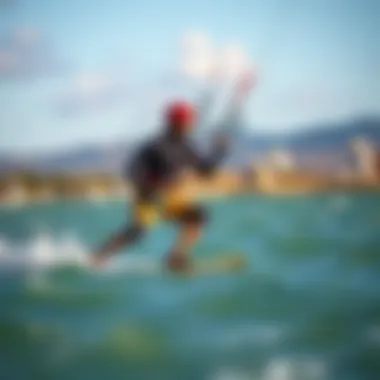
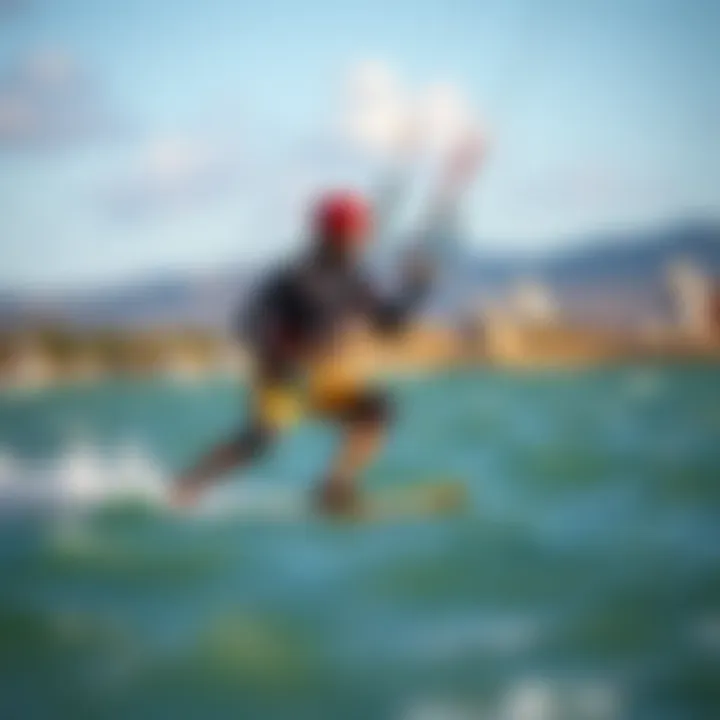
Intro
Kiteboarding is more than just a thrilling sport; it's a gateway to adventure and exploration. For those who are just dipping their toes into this exhilarating activity, understanding the fundamental components of a kiteboarding beginner kit is crucial. You may find yourself overwhelmed by the plethora of gear available, but fear not! This guide aims to simplify the maze of equipment, helping you equip yourself with the right tools to hit the water with confidence. In this exploration, we will break down not only the essential gear you’ll need for a safe start but also delve into accessories that will enhance your kiteboarding experience.
Gear and Equipment
When starting out in kiteboarding, your choice of gear can make or break your early experiences. Relying on quality products ensures not only your safety but also solid performance as you learn the ropes. Let’s dive into the essential kiteboarding gear for beginners.
Essential Kiteboarding Gear for Beginners
- Kite: The heart of kiteboarding. For novices, a smaller and more manageable kite is ideal, as it offers more control, making the learning curve smoother. Look for kites specifically designed for entry-level riders, often characterized by stability and ease of use.
- Board: A beginner board typically has a larger surface area, offering more buoyancy and stability. This type of board makes it easier for new riders to maintain balance while learning the necessary techniques. Brands like North Kiteboarding and Slingshot have excellent beginner boards worth exploring.
- Harness: This component is crucial for connecting you to the kite. A comfortable harness allows for greater control and reduces strain on your arms. Waist harnesses are popular among beginners because of their forgiving fit.
- Safety Gear: Don’t overlook the importance of safety equipment. A reliable impact vest and helmet are vital for protecting yourself against potential accidents. Depending on your local conditions, wrist guards may also be wise to consider.
- Pump: An efficient pump is essential for inflating your kite. Opt for a pump that features user-friendly designs, as it will make the tedious task of inflating significantly easier, getting you on the water faster.
When starting out, it would be advantageous to rent or borrow gear as you get a feel for what works best for you before making any significant investments.
Advanced Equipment for Experienced Riders
As you progress and gain experience, your equipment needs may evolve. Here, the focus shifts toward performance and personal preference. Some points to consider include:
- High-Performance Kites: As your skills develop, you may want to experiment with different kite shapes and sizes that offer increased agility and speed.
- Different Board Types: Freestyle or wave riding boards offer distinct styles for more advanced maneuvers. Each design serves a purpose and can greatly impact your performance in the water.
- Tweaked Harnesses: Looking into specialized harnesses like seat harnesses or those with quick release systems can make a difference in comfort and safety while riding.
"Choosing the right gear is as important as the skills you develop. It's about finding a balance between comfort, control, and your personal style."
Techniques and Tips
Once you have your gear sorted, shifting focus to the techniques is the next crucial step.
Basic Riding Techniques for Newbies
It’s essential to familiarize yourself with fundamental riding techniques. Here are several tips to keep in your back pocket:
- Body Positioning: Stay relaxed and keep your body low to the board for stability.
- Steering the Kite: Practice controlling your kite by making gentle movements. Oversteering can lead to unintended crashes.
- Water Starts: This is an important first move. Position the kite correctly above your head while lying on your stomach, then use the kite's pull to lift you onto your board.
Expert Tricks to Elevate Your Skills
As you gain more comfort, you may look into advanced tricks like jumps or spins. Connecting with experienced riders, whether through community forums or local clubs, can provide valuable insights as you progress.
In sum, kiteboarding can be incredibly rewarding. By equipping yourself with the right gear and techniques, you'll be setting the groundwork for a thrilling journey ahead. Don't forget to seek out local kiteboarding communities or reputable kiteboarding schools for additional support during your learning process.
Understanding Kiteboarding Essentials
Kiteboarding can appear like a whirlwind of colors and sounds to the untrained eye, yet beneath those vibrant kites lies a world steeped in technique, equipment, and safety. The significance of understanding kiteboarding essentials cannot be overstated, especially for those just starting to dip their toes into this thrilling sport. Without a solid grasp of the basics, gear selection can be overwhelming, potentially deterring budding enthusiasts before they've ever flown their first kite.
Before hitting the water, acknowledging the foundational components of kiteboarding is crucial. This section simplifies the key elements and highlights the invaluable benefits they offer to newcomers. Emphasizing knowledge about equipment intertwines with safety and performance—two pillars that can make or break a kiteboarding experience.
In addition, considering weather conditions, personal comfort, and financial constraints can further tailor your kiteboarding journey. This article aims to equip you with insights that guide you in making informed and confident decisions.
Defining Kiteboarding
Kiteboarding, sometimes referred to as kitesurfing, merges the excitement of surfing with the lift of kite flying. Essentially, it involves riding a board, propelled by a large, powerful kite that is controlled by the rider using a control bar and lines. The rider utilizes the power of the wind, steering the kite in various directions, thus navigating the waves or flat water.
The beauty of kiteboarding lies in its versatility; whether you seek to cruise along a serene lake or perform acrobatics in ocean waves, there's a style for everyone. As the sport continues to grow globally, its community fosters a vibrant culture, encouraging budding kiteboarders to explore the tapestry of experiences it offers.
The Importance of Proper Equipment
Investing in the right gear is paramount for any kiteboarder. Just as a culinary chef needs quality knives, a kiteboarder requires appropriate equipment for a successful outing. Proper equipment not only enhances performance but is also a significant factor in ensuring safety.
When selecting your initial set of gear, one must consider:
- Mateials and Build Quality: Investing in durable, high-quality items will yield better longevity and safety in the long run.
- Size and Fit: Many equipment components must be suited to the rider's size and skill level. A kite that is too large for a beginner can easily lead to trouble.
- Safety Features: Modern equipment often incorporates safety systems that provide essential release mechanisms to avoid dangerous situations.
"Quality gear can enhance your skill level, making it easier to learn and advance in your kiteboarding journey."
To navigate the complexities of initial purchases, it's wise to seek advice from experienced riders or trusted instructors. Attending demo days or renting equipment prior to buying can help narrow down choices and lead to more satisfying decisions. With a clear understanding of kiteboarding essentials, beginners can embark on their adventure with a sense of purpose, destined to experience the thrill of the experience.
Key Components of a Beginner Kit
When venturing into the world of kiteboarding, having the right gear can make or break the experience. The key components of a beginner kit serve as the foundation for your learning journey. Each item plays a vital role not only in performance but also in safety. Without the proper components, kiteboarding can quickly become an overwhelming endeavor. Thus, knowing what these components are is quintessential for anyone looking to dive into this exhilarating sport.
Kite Selection
Different Types of Kites
Choosing the right type of kite is essential for a beginner. Generally, there are two main types: inflatable kites and closed-cell foils. Inflatable kites are popular because they are easier to handle and have better stability. Their design allows for easy relaunch after a crash, which is a common occurrence when you're just starting out.
On the other hand, closed-cell foils tend to be a bit more challenging due to their reliance on wind for performance, but they are typically more compact and lighter. While inflatable kites provide a gentle introduction, foil kites can be a rewarding challenge.
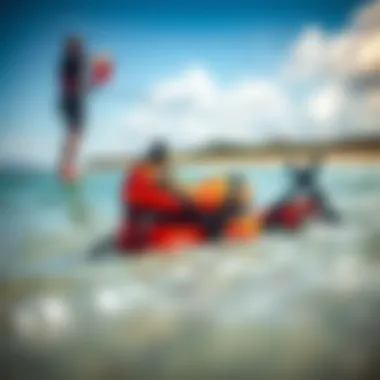
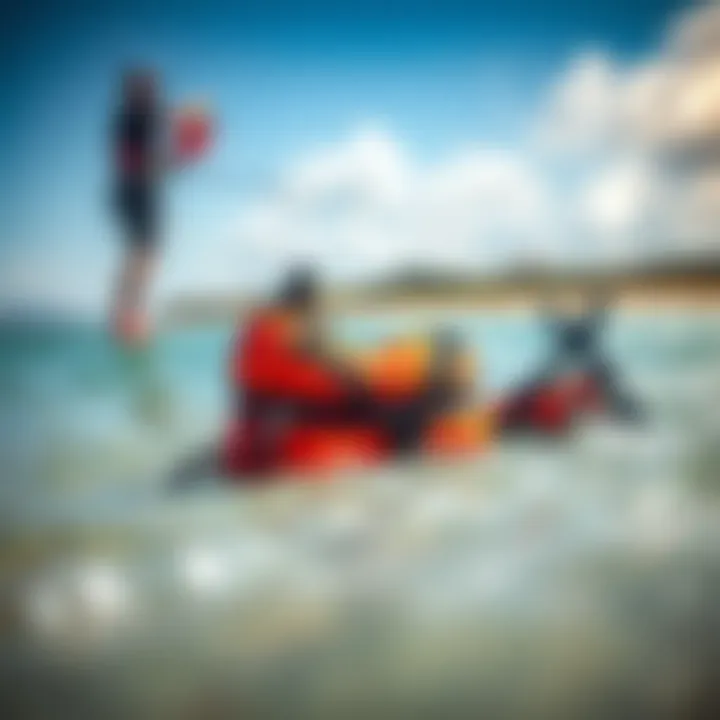
"Choosing the right kite style can dramatically affect your learning curve and overall enjoyment while kiteboarding."
Size Considerations
Size plays a crucial role in your kiteboarding experience. Generally, larger kites catch more wind, making them great for lighter winds, while smaller kites are best suited for stronger breezes. For beginners, a medium-sized kite ranging from 9 to 13 square meters is often recommended. This size gives a perfect balance between power and control. Keep in mind that overestimating your needs can lead to difficulty—it's better to start small and gain confidence.
Brand Recommendations
When considering brands, it’s wise to lean towards those known for their reliability and quality. Popular makers like Cabrinha, Naish, and Duotone have a longstanding reputation in the kiteboarding community. They offer excellent customer support and beginner-friendly kites. However, lesser-known brands may also have great options, so don’t shy away from exploring alternatives. Research reviews and user experiences to make an informed decision.
Control Bar and Lines
Function and Features
The control bar is what allows you to steer the kite, making it a critical component of kiteboarding. A well-designed bar should feel intuitive in your hands. Features like adjustable widths and ergonomic grips offer added clarity and ease while you ride. Many control bars also come equipped with quick release systems, which enhance safety by allowing you to disconnect the kite rapidly in emergencies.
Line Length Variations
Line length can significantly impact performance and handling. Most beginners will find that lines between 20 and 24 meters provide a good balance between control and power. Shorter lines increase responsiveness, which can be beneficial, while longer lines provide more power and speed, but they are harder to manage. Opting for adjustable line lengths may be a smart move until you're prompted to make a permanent choice.
Safety Systems
Safety systems are crucial in kiteboarding, especially for beginners who are still mastering their skills. Look out for features like self landing mechanisms and safety leashes. A reliable safety system can greatly reduce hazards and make your time on the water more enjoyable. Many brands have invested heavily in safety technology, ensuring it is easily accessible and straightforward to use.
Harnessing Techniques
Types of Harnesses
Harnesses come in different styles, primarily waist and seat harnesses. For newcomers, a waist harness, which sits around your waist and is generally less restrictive, can be a better choice. It allows for a greater range of motion while riding. Seat harnesses, while offering more support, may not lend the same flexibility. Ultimately, your choice will depend on comfort, riding style, and personal preference.
Fit and Comfort
Finding a harness that fits well is essential for a pleasant riding experience. It should feel snug without being restrictive. A dangling harness can make it difficult to control the kite effectively. When trying on a harness, consider how it feels during movement; adjustments may be needed for a perfect fit.
Choosing the Right Harness
To choose the right harness, consider factors like the type of riding you'll focus on and how long you intend to use it. First-time riders may prioritize comfort over performance. Furthermore, listening to feedback from other kiteboarders can steer you towards suitable options within your budget.
Board Basics
Types of Boards
Different boards serve various purposes in kiteboarding, and understanding their types is key. The two main styles are directional and twin-tip boards. Directional boards are often favored for wave riding, while twin-tip boards can be ridden forwards and backwards, offering versatility for beginner kiteboarders. Ease of use in tacking back upwind should be top priority for new kiteboarders.
Size and Shape Factors
Board size and shape can influence how easy or challenging you find it to learn. A larger board gives more stability and is easier to ride, making it a wise choice for beginners. Conversely, narrower boards can offer improved performance as you progress, but might require more skill to handle effectively.
Recommended Beginner Boards
When starting out, consider boards from established brands like Liquid Force or Slingshot. Boards in the range of 130 to 150 centimeters tend to be suitable for gaining skill without unnecessary frustration. Ensure the board has a durable finish; minor dings in the beach can happen easily, but some boards are made to withstand the bumps and bruises of learning.
Complementary Gear for Beginners
When diving into kiteboarding, having the right gear isn’t just a luxury, it’s essential for both safety and enjoyment on the water. Complementary gear acts as the supporting cast to your primary kiteboarding kit, ensuring you remain safe, comfortable, and prepared for varying conditions. From protective equipment to appropriate footwear, each piece holds significance in shaping a positive experience, which no beginner should overlook. This is especially true when you're first learning; a satisfying outing can make all the difference.
Safety Equipment
Impact Vests
Impact vests are designed to provide a layer of protection against the various impacts associated with kiteboarding, whether from falls or being hit by your own kit. One key characteristic of impact vests is their foam construction, which offers buoyancy while shielding your torso. This makes it a popular choice for beginners who may not yet have mastered their balance and control.
The unique feature of impact vests is their ability to float while giving that extra cushioning. You get a sense of security knowing that if you take a tumble, the vest can absorb some shock. However, it’s important to remember that impact vests are not a substitute for a buoyancy aid; they do not provide the same level of floatation. Hence, having both is wise to ensure you're safe and sound.
Helmets
Helmets are another fundamental piece of safety equipment that kiteboarders should consider. One important aspect of helmets is their ability to protect your head from accidental falls and unexpected impacts—something that can be crucial, especially for beginners who are still finding their feet.
The standout feature of wearing a helmet is the reassurance that comes with it. It can prevent serious injuries from impacts that might happen in choppy waters or during high-speed turns. However, some may find them a bit uncomfortable at first, especially when trying to concentrate on learning how to ride.
Other Protective Gear
Additional protective gear encompasses a variety of options, from knee pads to full protective suits. What’s notable about this gear is how it caters to personal preferences and natural risk tolerance. Some riders opt for additional padding, especially when practicing jumps or tricks, as this can help mitigate potential injuries.
A key feature of this segment is versatility—whether you're looking for full-body protection or targeted support, there are options available. The downside is that not everyone might find it necessary, especially if they're just starting out, so weighing the pros and cons based on your level of risk is vital.
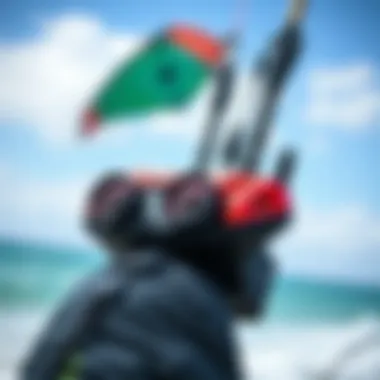
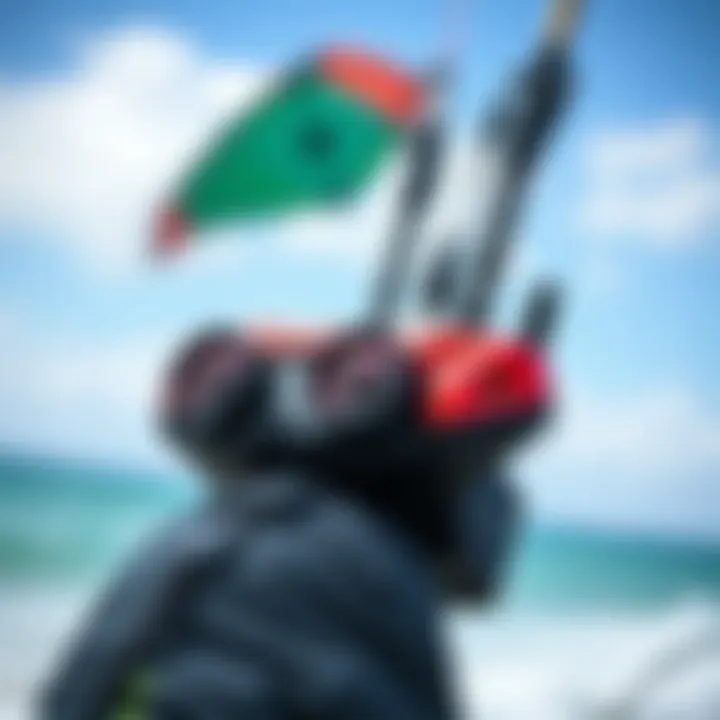
Footwear Considerations
Bindings vs. Barefoot
Choosing between bindings or going barefoot can significantly affect your kiteboarding experience. The core aspect of bindings is that they provide a secure fit, allowing for better control of your board. With bindings, you can perform maneuvers more effectively without worrying about losing your footing.
On the other hand, the unique characteristic of going barefoot is the feeling of freedom and direct connection with the board. This choice can be less restrictive, promoting movement and flexibility. However, keep in mind that without bindings, you may have a higher chance of losing your board during a tumble.
Shoe Selection
When it comes to shoe selection, the key factor is finding the right balance between comfort and functionality. Various shoes like water shoes and sandals can enhance grip on the board while ensuring your feet stay protected from sharp objects in the water.
One notable feature in water-specific shoes is their drainage systems, which allow water to flow out rather than accumulate inside. This can be a double-edged sword, as such shoes may lack the cushioning and support seen in traditional footwear, but they emphasize performance on the board quite well.
Accessing Board Performance
Accessing board performance is crucial for any beginner looking to maximize their time on the water. The focal point here is to understand how your gear impacts your experience and ability to learn. Experimenting with different setups can lead you to discover what suits your style and comfort best.
What’s interesting about board performance is the direct correlation between board size, type, and rider ability. Beginners often find that tailoring their equipment to their skills can significantly affect their learning curve—however, adjusting to a new board may take time and patience.
Wetsuits and Weather Gear
Thermal Protection
In kiteboarding, thermal protection can’t be overlooked, especially when participating in cooler waters or conditions. The key aspect of thermal suits is providing warmth while also allowing for movement. For those just starting, having suitable thermal protection can mean the difference between a fun outing and an uncomfortable day cut short.
A unique feature of modern wetsuits is their flexible materials that allow for a range of motion, making riding so much easier. However, one should be cautious as poorly fitting suits can limit mobility and, ultimately, enjoyment of the sport.
Material Types
Various materials used for wetsuits dictate comfort and thermal efficiency. From neoprene to thin flexible textiles, what’s important is choosing a suit that matches the water climate you’ll face most often. The key characteristic of materials like thicker neoprene is their heat retention, but they can be less forgiving in terms of mobility.
A noteworthy disadvantage is that while thicker may be warmer, it may also feel bulkier, making it tricky to maneuver initially. For beginners, finding the right balance in material thickness for the predicted weather can play a significant role in their comfort.
Fit and Mobility
Fit and mobility are crucial in selecting any wetsuit. What you should focus on is finding a wetsuit that hugs your body without restricting movement. A well-fitted suit enhances your kiteboarding experience, allowing for a greater range of motion on the board.
A unique aspect here is that many modern wetsuits are designed with innovations in fit technology that cater to various body shapes. While a good fit can enhance performance, poor fitting suits can lead to discomfort and distractions on the water.
In kiteboarding, the success of your day largely hinges on your gear selection. Thus, pay careful attention to these complementary items for a more enjoyable and safe experience.
Additional Accessories
In the sport of kiteboarding, additional accessories often represent the glue binding the entire experience together. They complement the main gear while ensuring safety and enhancing performance. For beginners, investing in these accessories can make a significant difference.
Repair Kits
Essential Repair Tools
Repair kits are not just a luxury but a necessity for kiteboarders. Ensuring you have essential repair tools can be the difference between a day out on the water and sitting on the beach, watching others ride.
Key tools often found in these kits include:
- Patches: Typically made from durable fabrics, useful for sealing punctures in kites.
- Levers: Great for quick adjustments in the field.
- Duct tape: This faithful companion can surprisingly handle various fixes.
What makes having these tools beneficial is their portability; they are easy to carry and can serve multiple purposes when required. Not to mention, being able to repair your gear on the spot keeps you in the game longer.
On the downside, if you're not familiar with how to use these tools, there could be a steep learning curve. It can also take time to become proficient in spot repairs without compromising the integrity of your gear.
Maintenance Best Practices
Regular maintenance is part and parcel of kiteboarding. Developing sound maintenance best practices can prolong the life of your gear significantly. For instance, washing your kite after every session can prevent salt build-up, which is harmful in the long run.
A common recommendation is to:
- Dry your gear properly after each use to avoid mold or deterioration.
- Inspect lines and bars regularly for frays or wear and tear.
The key characteristic here lies in being proactive rather than reactive; it often saves both time and money. However, keeping up with maintenance requires diligence and a real commitment. Some beginners may find this aspect tedious, preferring to hit the water rather than spend time caring for their equipment.
Emergency Repair Techniques
Mastering some simple emergency repair techniques can ensure that you're never left high and dry. Knowing how to effectively tack on a patch or tie a secure knot can come in mighty handy when you find yourself in a pinch.
Key methods may include:
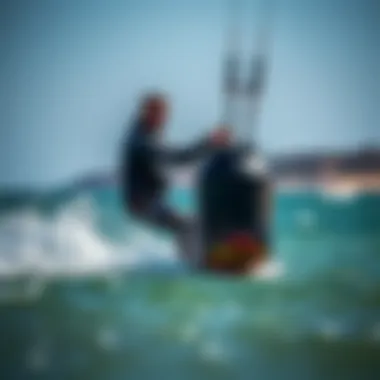
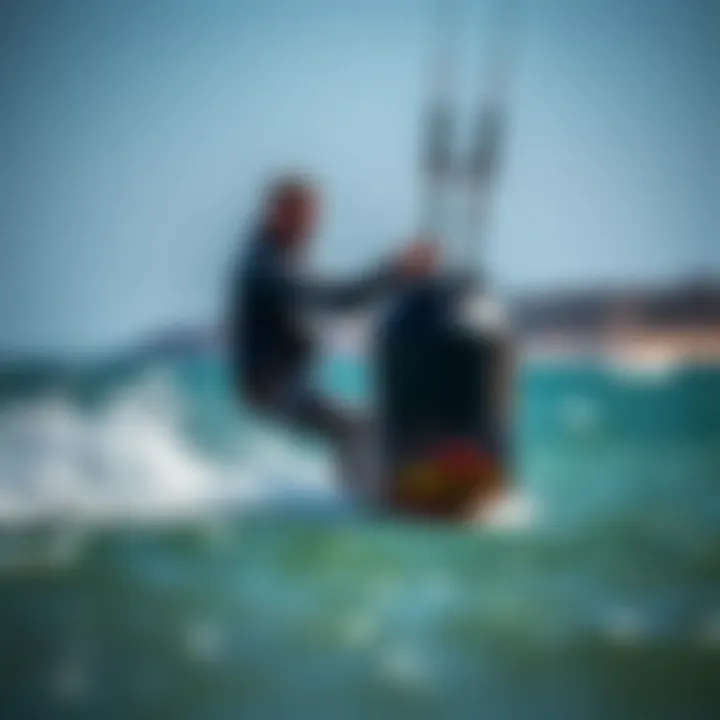
- Use of windbreaks for kites that have suffered from line tangles.
- Knot tying techniques to secure loose components.
The essence of these techniques is quick fixes that get you back on the water swiftly. One downside, however, is that while these repairs can be effective for immediate action, they might not hold up for long-term usage. Nevertheless, having these skills can turn a potential disaster into a minor inconvenience.
Storage Solutions
Gear Bags Overview
When it comes to gear bags, you can never be too picky. They serve a crucial purpose in keeping your equipment safe and organized. A well-structured gear bag should offer ample space for kites, boards, harnesses, and more, making it easier to travel with all your essentials.
Look for bags that include:
- Dedicated compartments for each item, to avoid unnecessary wear and tear.
- Durable materials that can withstand the rigors of travel.
The key characteristic of a good gear bag is its capability to provide efficient organization while being easy to transport. Equip your bag with wheels if you're planning to lug it over long distances. However, heavier bags can become cumbersome for beginners not used to hauling their gear.
Portability Concerns
Portability concerns become particularly relevant when you're hopping from one spot to another. An ideal bag should not only protect your gear but also allow you to be mobile without breaking your back.
One aspect to think about includes:
- Weight distribution: Look for ergonomic designs that distribute weight evenly, making it easier to carry.
A lightweight bag will win the day over a bulkier option, especially when navigating crowded beaches or rocky terrains. On the flip side, lighter materials might not offer the same level of protection, so balance is essential.
Protective Storage Recommendations
Protective storage recommendations play a vital role in keeping your gear in top condition when not in use. Storing kites in a temperature-controlled environment can preserve their elasticity and performance.
Consider these tips:
- Clean your gear before storing it away; it can save you a headache later.
- Use proper kitesurf bags designed to shield against pressure and extreme conditions.
The important takeaway is to keep your gear well-cared for and stored safely when you're not using it. However, finding the right storage can be a challenge if you're dealing with limited space, particularly in smaller living situations or during travel.
In the end, understanding these additional accessories can greatly enhance your kiteboarding experience as a beginner. By investing in the right tools and storage solutions, you’ll find your venture into the kiteboarding world much more enjoyable.
Tailoring Your Kit to Your Needs
Selecting the right gear for kiteboarding is not a one-size-fits-all scenario. Every beginner has unique needs based on personal comfort, skill level, and budget. Understanding the nuances of tailoring your kit can make a significant difference in how quickly and effectively you progress in the sport. This section dives into the critical aspects you should consider to ensure your setup aligns with your requirements.
Evaluating Skill Level
Transitioning from Beginner to Intermediate
When you first step into the world of kiteboarding, everything can feel quite daunting. Transitioning from a beginner to an intermediate kiteboarder is crucial and contributes significantly to your confidence and skill development. This transition usually involves a deeper understanding of kite control, board handling, and the ability to navigate different wind conditions. The key characteristic of this stage is the empowerment that comes with improved coordination and technique. The benefits of progressing include more thrilling rides and the ability to tackle various conditions.
For instance, many beginners might try to ride waves after only a few practice sessions. This is often challenging and can lead to discouragement if they haven’t fully mastered the basics. The unique feature of this phase is realizing that it’s okay to take a step back and strengthen foundational skills before pushing forward. Not giving yourself this time might lead to unnecessary frustration. This deliberate pacing can build a solid base that enhances your overall kiteboarding experience.
Gear Adjustments
As you transition in skill, your gear may also need adjustments. The importance of gear adjustments cannot be understated. Depending on a kiteboarder's experience, the equipment might need to shift from beginner-friendly brands to more advanced models that offer better performance. The essential characteristic of this adjustment process is to find the perfect balance between comfort and progression. For instance, as you gain more experience and confidence, switching from a wider beginner board to a narrower, more advanced one can allow for quicker turns and better maneuverability.
However, keep in mind the challenges that may arise during this shift; the learning curve can be steep. You may find that your initial board feels restrictive. Alternatively, a more advanced board could be less forgiving. So, knowing when to make these adjustments will keep you on the right track to enhancing your skills rather than limiting your potential.
Continuous Learning
Engaging in continuous learning affects your journey profoundly. Kiteboarding is not just about the gear but understanding the dynamics of the sport. The essence of this characteristic lies in the commitment to improve and seek knowledge consistently. Joining local kiteboarding clubs, participating in workshops, or connecting with seasoned riders—the benefits are manifold.
The unique element here is the vast ocean of resources available. Whether it is watching instructional videos on YouTube or diving into forums such as reddit to learn from experienced kiteboarders, the options are endless. While sometimes overwhelming, maintaining an attitude of curiosity can open doors to quicker progression. It is critical to embrace new techniques and approaches, as being stagnant can stifle growth in this fast-paced sport.
Budget Considerations
Balancing Quality and Cost
Budgeting for kiteboarding gear often poses a significant challenge. The need to balance quality and cost is central to beginners' decisions. Investing in quality gear can lead to better performance and prolonged use, while skimping can lead to early replacements or safety issues. Many newcomers believe higher-priced gear is better, but sometimes it’s smart to focus on durable, versatile equipment that serves your current skill level.
What many find beneficial in this approach is that an excellent balance can be struck even on a limited budget. This characteristic encourages thoughtful purchasing decisions and ensures longevity in your kit. Suppose you’re just starting; renting high-end equipment before investing can provide valuable insights into what works best for you without a considerable initial investment.
Second-Hand Gear Options
Exploring second-hand gear options is another way to stretch your budget. Buying pre-owned equipment allows beginners to access higher-quality items without breaking the bank. Many enthusiasts sell their gear as their skills progress. This practice helps both sellers and buyers; one can recoup some costs while the other receives a well-maintained kit. The beauty of second-hand gear lies in the potential to snag deals on quality items that might have been slightly used.
Nonetheless, caution is vital. Examine items for any damage or excessive wear, as these factors can impact performance. Networking through local kiteboarding communities can lead to reliable sources for good second-hand equipment.
Sourcing Affordable Equipment
Finding affordable equipment can often seem like finding a needle in a haystack. But with a little research, you can derive great options without sacrificing quality. Specialized shops, online marketplaces, and local forums are excellent places to scout for deals. The notable perk here is that a plethora of resources exists, catering to various price points. Understanding seasonal sales, off-season purchases, or bundle deals can also significantly benefit your pocketbook.
What sets this aspect apart from others is the approach of being proactive. Relying solely on impulse buying or waiting for opportunity without research can be costly. With patience and effort, you can create a reliable kit that meets both your expectations and your budget constraints.















